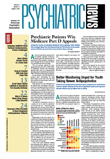The use of the antidepressant bupropion XL to prevent recurrences of major depressive disorder in adults with winter seasonal affective disorder (SAD) was approved by the Food and Drug Administration (FDA) in June.
Bupropion XL is the first medication to receive FDA approval for SAD. It already has FDA approval for treatment of major depressive disorder.
Use of bupropion XL is appropriate for patients who report that mood disturbances disrupt their work and family life nearly every winter, said Jack Modell, M.D., vice president for clinical psychiatry-North America at GlaxoSmithkline, the drug's manufacturer. People who report infrequent SAD or no significant impairment from their symptoms should not be treated prophylactically, he said.
The FDA's approval was based on findings from three similarly designed prospective, double-blind, placebo-controlled studies involving 1,042 adults at 151 sites in the United States and Canada (Psychiatric News, June 2). These individuals reported 13 previous episodes of SAD on average.
Study participants started taking bupropion XL between September and November, a few months before their symptoms usually appeared, and continued until April, when their symptoms typically faded.
Among all participants, 84 (16 percent) of those taking the medication experienced an episode of major depression, while 142 (28 percent) of those taking a placebo did so, Modell and colleagues reported in the October 15, 2005, Biological Psychiatry.
Symptoms of SAD typically emerge in late fall as hours of daylight lessen and remit in spring as days lengthen. An estimated 1.5 percent of adults in south Florida and about 9 percent of adults in the northern United States have SAD. In addition to depression, people with SAD often report carbohydrate cravings, overeating, and weight gain, as well as lethargy and increased sleep. SAD symptoms rarely become so severe that patients need hospitalization.
SAD symptoms usually come on gradually and respond quickly to bright-light therapy, the mainstay of treatment for SAD, said Alfred Lewy, M.D., professor and senior vice chair of psychiatry at the Oregon Health and Science University School of Medicine in Portland. Lewy was a co-originator of light therapy in the early 1980s.
“You get a clinically satisfying result with light therapy within a week or two,” Lewy said. “If patients stop therapy and clinical depression returns, they can restart it and get a remission again.” The usual regimen involves 30 minutes of daily exposure to 10,000 lux light, generally in the morning.
Light therapy has a good record of success in treating SAD, said Lewy. Nonetheless, since SAD is reliably recurrent, “it is the perfect model for testing whether an antidepressant can prevent depression,” he added. If results from the bupropion-XL study prove generalizable, he said, they hold the promise of possible preventative treatment for other types of depression.
“The downside of giving preventative treatment is that some people may not need it,” cautioned Raymond Lam, M.D., a professor of psychiatry and head of clinical neuroscience at the University of British Columbia. Fewer than 1 in 3 participants taking the placebo in the bupropion-XL studies experienced a relapse, he noted. “The downside of waiting for symptoms to appear,” he commented, “is that sometimes you wait too long.”
“Some patients say it's a nuisance to have to sit in front of a light box,” said Michael Young, Ph.D., an associate professor and director of clinical training in the Institute of Psychology at Illinois Institute of Technology in Chicago and immediate past president of the Society for Light Treatment and Biological Rhythms. Using medication prophylactically, he noted, also involves inconvenience and potential side effects.
“My bias as a clinician,” said Young, “is not to treat unless we have something demonstrable to treat.”
The Web site of the Society for Light Treatment and Biological Rhythms can be found at<www.sltbr.org>.▪
